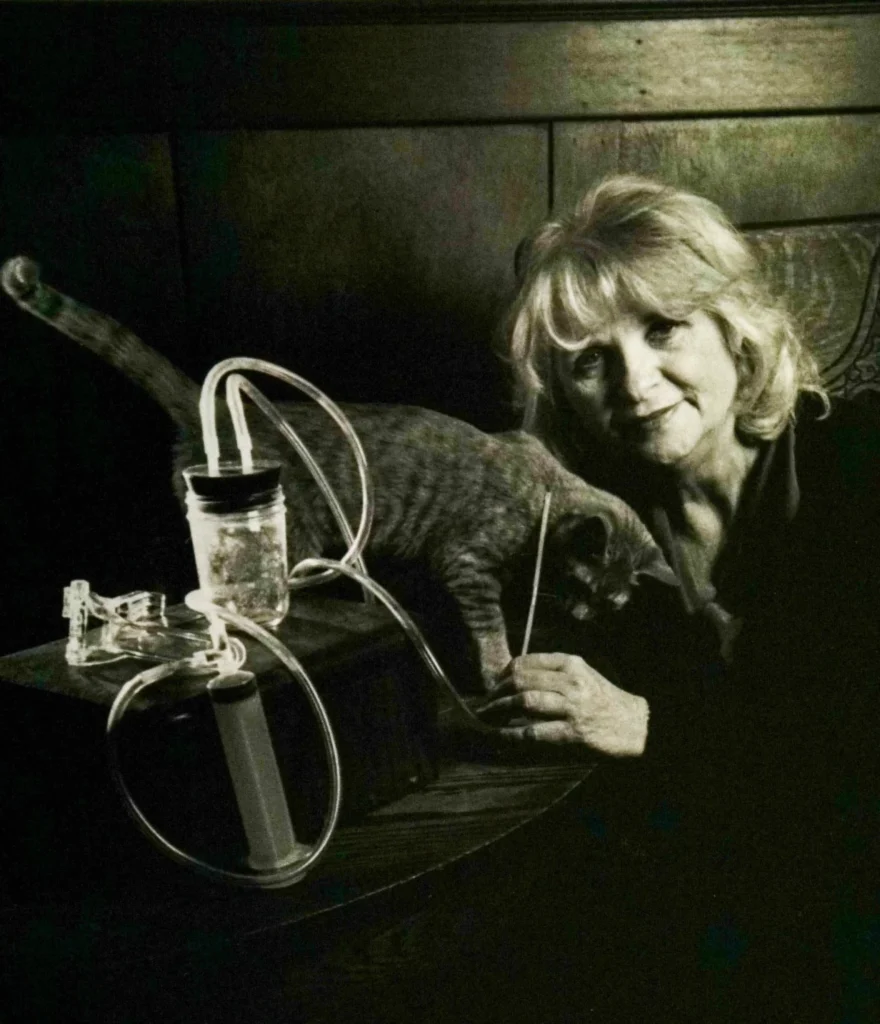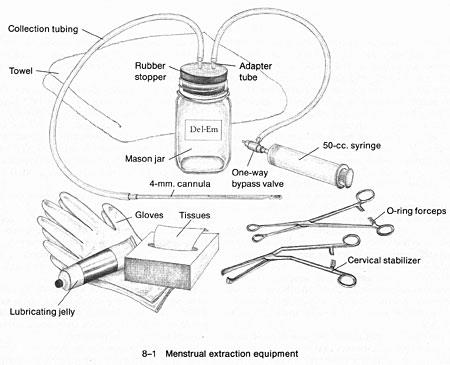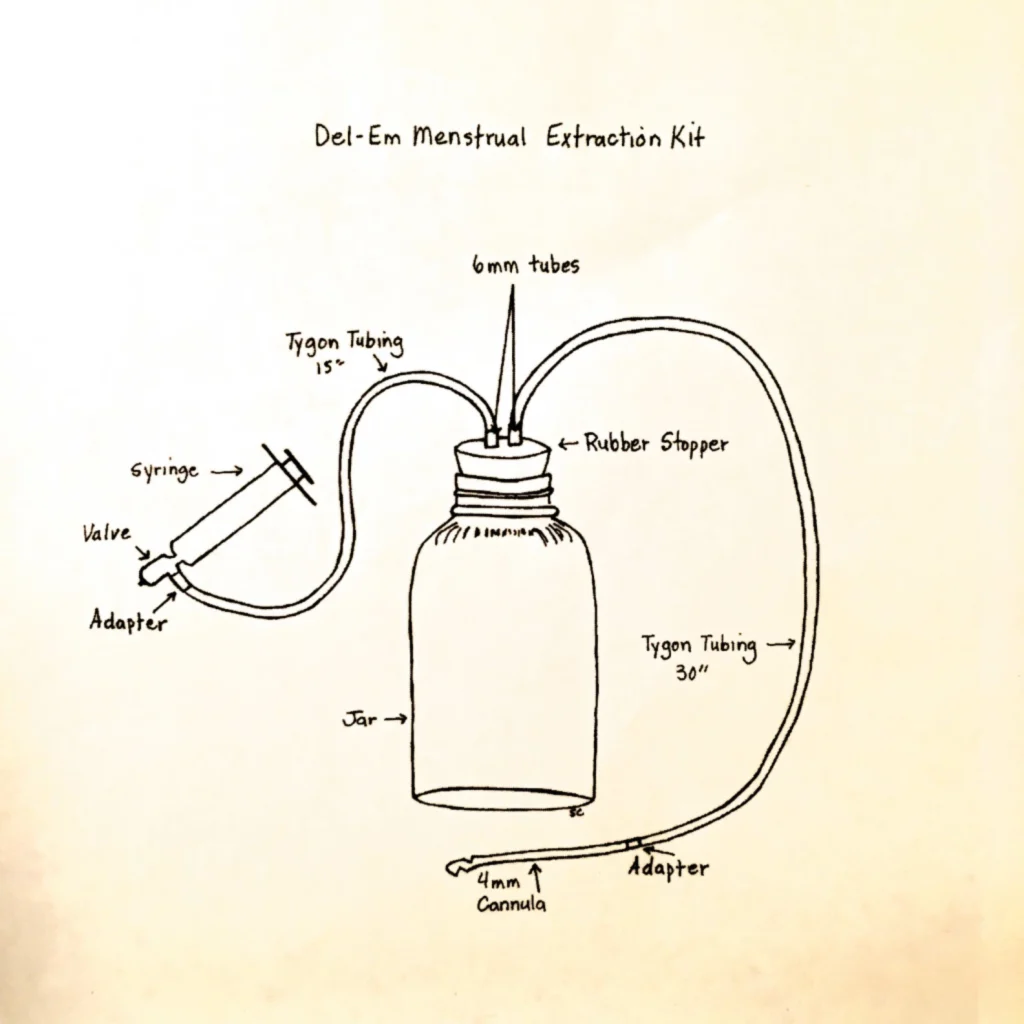Carol Downer, a life-long advocate for women’s liberation, died on Jan. 13 at the age of 91. Rest in power.

Before Roe v. Wade, women developed ways to help themselves get the care that states banned and most medical professionals refused to provide. Some used herbs, but many learned a technique feminists called “menstrual extraction,” using a syringe, flexible plastic tubing and a mason jar to extract the contents of the uterus. At the time, doctors who provided medically necessary abortions used a much more invasive and painful procedure that involved stretching the cervix and scraping the uterine walls. Later, doctors adopted these aspiration techniques developed by women’s health advocates.
Carol Downer was centrally involved in forming the women’s self-help movement, which taught menstrual extraction and led to the invention of the Del-Em abortion kit by Lorraine Rothman. In 1971, Downer and Rothman opened the first self-help clinic—the Feminist Women’s Health Center—in Los Angeles, which later became a model and inspiration for dozens of self-help clinics across the country, including in Oregon, Washington, Florida and Georgia.
The goal of the clinic was to “take women’s medicine back into [their] own hands.” The self-help movement challenged the mystification, objectification and stigmatization of women’s bodies as well as male doctors’ control over women’s health.
Ms. magazine spoke with Downer about her experiences with menstrual extraction and how it could help women after Roe.

Carrie Baker: How did you react when the Dobbs decision came down?
Downer: It was devastating. Not that I didn’t expect it. Actually, I was expecting it many years ago. Roe has hung in there a lot longer than all of us had predicted that it would. Nevertheless, it’s just totally, totally, totally shattering. Everyone I’ve spoken to had the same response. I’ve heard from people I haven’t heard from in years reaching out to share their devastation.
We are in a different world. American women really believed they had these rights. They honestly thought that we had made progress. That it couldn’t just be taken away from us. Women are waking up. We’re gonna have some really harsh, heartbreaking times.
Baker: Do you remember how you reacted when Roe came down in 1973?
Downer: To all of us on that particular day, it was a big surprise. However, the fact that it was coming was not. We had a groundswell. I’m not speaking of the second wave. I’m speaking of at least a 10-year, maybe a 20-year, buildup to Roe. The forces of the media, doctors, lawyers, ministers, employers—the whole country—was abuzz. We were very busy running around giving presentations to people in the community who wanted to know about abortion. They got scared. They saw that we were on the march.
Did you know that “menstrual extraction” is mentioned in Blackman’s Roe decision?
Baker: Wow! I didn’t know that.
Downer: He mentioned it in the context of alluding to several technological things that were taking place.
Baker: You coined that phrase, right?
Downer: Yes. We felt they glimpsed the fact that they had to quickly get in there and give us this right or we were going to figure out most of the feelings that had been inculcated in us socially and we were going to tear it all down.
Baker: What motivated you to work on this issue?
Downer: I had an illegal abortion that was quite a searing experience. Better than most women’s as a matter of fact, but life-changing as far as my attitudes toward the subject.
Getting Involved in Menstrual Extraction
Baker: How did the self-help movement start?
Downer: What it comes down to as far as my own involvement was this very simple tool called a speculum, which is what doctors use to open up a woman’s vaginal walls so that they can access the cervix, which is the entrance to the uterus. They use speculums to do abortions, for example, or help to deliver a baby or check on the health of the cervix.

Downer: In 1971, I was on the abortion committee of the Los Angeles chapter of the National Organization for Women. I came in contact with Mary Petrinovich, who was one of the three people who were on the committee. Mary took me over to this little abortion clinic on Santa Monica Boulevard in West Hollywood. The clinic was run by Harvey Karman, who called himself a doctor, which he was not. Mary brought women from Riverside, where her husband was a professor at the University of California, to get abortions.
One day we were hanging around Karman’s clinic where these illegal abortions were being performed and Mary said, “Carol, why are we letting this male doctor do this? You know, we could do this.” And yes, it had become very obvious to us that was true.
Karman was using a new procedure, much improved over the common D&C [dilation and curettage] procedure that was being done at the time, legally and illegally. D&C procedures involved scraping the wall of the uterus with a metal instrument. It did the job. It was overall safe, especially if somebody had training. But it still had complications because it used metal in the uterus, which could puncture the uterine wall and cause a life-threatening emergency.
I had a D&C with my illegal abortion and it was incredibly painful because they stretched the cervix using a series of rods that are larger and larger to gradually open the cervix. That process went on for maybe five or 10 minutes at the most, but it was pure hell. Then you can hear the scraping—scrape, scrape, scrape, scrape, scrape. It’s very rough.
At that time, when abortion was illegal, conscientious doctors thought it was very important to be rough because they had to guarantee that they got everything out. Because once you walked out the door and went back to your community, whether it was in a neighboring town or in a neighboring state, you are not there to help that woman.
Karman’s procedure avoided all that because he used a smaller tube that was flexible and he used this syringe to extract the contents of uterus rather than scraping.
Conscientious doctors thought it was very important to be rough because they had to guarantee that they got everything out. Once you walked out the door and went back to your community, you are not there to help that woman.
Baker: Did Karman develop this method?
Downer: That is an open question. Definitely some version of this had been developed in China some years before that. And then I’ve read about a woman Dorothea Kerslake in London who had developed a similar type of device.
It’s hard to say what Karman’s individual contribution was, but I can certainly tell you that he promoted it and was very instrumental in getting it popularized. His contribution was immense. He deserved to get the very large, wonderful obituary in the LA Times, even though working with him on a personal level was like working with any male chauvinist man at the time.

Baker: Was Karman’s method less painful?
Downer: The woman feels her uterus clamping down. It’s uncomfortable, but not as bad as the D&C procedure.
Baker: How did you start doing procedures yourself?
Downer: Hanging around Karman’s clinic, we had picked up a lot of the information that we needed. It wasn’t that he taught us. He didn’t. But he was very casual. He was very laid back himself and informal. So we’d gotten tips on how to make the equipment as sterile as possible and what to look for. And we’d practiced on each other, done self-exams and done uterine size checks. But there were too few of us. No more than six or seven of us.
We needed more, so we placed an ad for a meeting in the Everywoman’s Newspaper. Of course, we didn’t want to say what we were about. We put in a bunch of vague stuff, but people got the message and 30 women showed up. At the meeting, my role was to show the equipment to the women. So I got out Harvey’s equipment, which by the way is now made by IPAS [International Pregnancy Advisory Service].

Downer: They call it manual vacuum aspiration or MVA. They insert the cannula into the cervix, then attach the syringe and draw out the contents of the uterus. It’s used in clinics today. Some doctors prefer to do it manually instead of attaching it to a machine because the machine can be very noisy and stress producing just in and of itself. MVA is just as efficient, just as fast and just as effective.
At any rate, I took it out and I proceeded to demonstrate it to them. This was 1971 and abortion was illegal, at least in many states, but it was legal in California. It had been legalized in 1967, but it wasn’t available. We had all heard about people dying from illegal abortions. These women were just sitting there in the shop and I was showing this equipment and how it works. But they just got freaked out. I could see it. One woman was turning white.
So I said, “Well, let me show you something.” I had myself had a very important change by having seen a cervix. It had totally changed my perception. I went over to a desk in an alcove nearby and asked them to come on over. I got up on the desk. I had on a long dress. I didn’t have on any underwear. I just laid back and pulled back my skirt. There was a gooseneck lamp. I put in the speculum, brought down the lamp and invited them to come over and look at my cervix.
I had no idea how they were going to respond. Here I was jumping up on the table exposing myself. Well, they rushed over. And the rest, as they say, is history. They took it for exactly what it was: a generous sharing of personal information for the benefit of other people. And suddenly we were in a big discussion. People were looking and saying, “What is that?” Someone asked, “How come yours seems to be so far back?” And I said, “Well, I have a tipped uterus. And my doctors told me that that’s why I got pregnant so easily.”
Mary offered to do a self-exam and other women got up the courage to do it also. One woman who got up, hers was tipped exactly opposite. She said, “My doctor told me that’s why I got pregnant so easily.” The whole room laughed. These old doctor tales. That just popped the bubble that doctors always knew what they are talking about.
Then another woman said, “I’m on my period” and people asked, “Can we see that?” So she got up. When she put in the speculum, there was her cervix with little streaks of red blood on it. She clearly was menstruating. The cervix is a knob-like structure. We took a little swab and there was no odor. We realized at that point that this odor of menstrual blood happened when it meets the air. It’s not the menstrual fluid itself. We instantly felt better about it.
Here I was jumping up on the table exposing myself. Well, they rushed over. And the rest, as they say, is history. In a few hours, these women went from being paralyzed with fear to thinking, “Hmm, I wonder what would happen if we use the Q-tip?”
Baker: What was your goal in showing them your cervix?
Downer: We felt ashamed given all the things it’s called, and how it’s treated in a patriarchal society. What I didn’t know was how quickly these negative feelings could be vanquished. That was the big surprise. Right away. In a few hours, these women went from being paralyzed with fear to thinking, “Hmm, I wonder what would happen if we use the Q-tip?”
I can’t overstate the difference seeing our cervixes made in our lives on a personal level, but also on a global level. Around the world in all cultures, we’ve never run into any group of women who weren’t delighted. They jump on the bandwagon immediately.
The whole room laughed. These old doctor tales. That just popped the bubble that doctors always knew what they are talking about.
Baker: What about seeing one’s cervix changes people?
Downer: People see the cervix as a very complicated thing, but it so happens that, in fact, it’s simple. The reality is, it was hidden from them, and now it’s not. They see it’s not ugly. And see the fact that, how in the world can that Supreme Court sit up there and deny this thing to us? How can they get away with that? You can guarantee that Amy Coney Barrett has not seen her own cervix.
Baker: What happened after that meeting?
Downer: Our next meeting took place the next week. Several things happened.
First, we changed the goals of the group from establishing an illegal women-controlled abortion clinic (non-physicians and non-accredited clinic), to teaching cervical self-examination in groups. We called these sessions, “Self-Help Clinics.” Articles about the self-help clinics appeared in the newspaper Sister, which announced our weekly meetings at the Women’s Center.
Second, Lorraine Rothman, who had travelled in from Orange County for the April 7 meeting after seeing the Everywoman’s Newspaper announcement, went home and designed a prototype of a device that could be used by women to do menstrual extraction, which she called the Del-Em. Lorraine worked in the lab of her husband Al Rothman, who was a biology professor at the University of California in Fullerton.
How in the world can that Supreme Court sit up there and deny this thing to us? How can they get away with that? You can guarantee that Amy Coney Barrett has not seen her own cervix.

The Del-Em consisted of a collection jar with two clear plastic tubes. One tube led to a four-milimeter flexible straw-like plastic cannula with holes notched near its tip that we inserted into the uterus to aspirate out its contents; the other longer tube led to a plastic syringe, which we pumped to create the suction. Along the tube that came out of the syringe, Lorraine inserted a one-way valve; this prevented the direction of the suction reversing, causing air to go into the uterus. We tested it out, but it needed a different container, because the plastic one she used collapsed when the air was suctioned out.
Over the next month or so, Lorraine modified the device. During that time, under Lorraine’s guidance, we developed the concepts of menstrual extraction, in which we redefined the significance of removing one’s menstrual period to include taking out the contents of the uterus at the time it is due or a little late, whether there is a fertilized egg in it or not.
We noticed that after the material starts coming down the tube, it can often be seen whether or not the changes that accompany fertilization have taken place. The material is more pinkish, watery and clumpy and moves more quickly through the tube. The contents of an ordinary menstrual period are usually dark red, thick and gummy and moves very slowly down the tube.
How-To: Menstrual Extraction
Baker: How did you do menstrual extraction?
Downer: Lorraine perfected this accessible way for ordinary women to do it. The main skill, frankly, that one has to learn in order to be good at doing menstrual extraction is how to estimate uterine size to determine how far along a pregnancy is. To acquire that skill, women practiced on each other in the group when they are not pregnant.
Basically, what happens is that a minimum of two, but usually three or four women are involved in doing a menstrual extraction. One woman guides the cannula. Another woman pumps the syringe. And another woman holds a mirror for the woman who is having the procedure so she can see the material coming out of her uterus into this tube and then to the collection jar.
The feature that Lorraine added to what Karman had was a one-way valve to keep from backing up. We used aquarium tubing and mason jars with a rubber stopper. It has been imitated by people. I’m personally aware of at least half a dozen varieties of Del-Ems that people have made using the same principles and different components, but it’s the same thing.
A minimum of two, but usually three or four women are involved in doing a menstrual extraction. One woman guides the cannula. Another woman pumps the syringe. And another woman holds a mirror for the woman having the procedure.
Baker: How do you make sure you get everything?
Downer: You have already examined the woman, so you have an idea of how far pregnant she is and how much material you should be getting out. I’ve seen many early abortions that would involve several syringes full of material. What happens when tissue remains is that you keep on bleeding. The uterus keeps trying to expel it. And oftentimes it becomes infected and that can be a problem. The solution, however, is very simple. You get back together and you finish it, redo it.
But the key thing with self-help groups is that this woman is accessible. She’s not coming from another state. You can follow up with her. We relied on a friendship circle that we had. Today suction is the method of choice. People are still doing D&Cs, but not usually.

Baker: How far into a pregnancy can you use menstrual extraction?
Downer: We recommend going up to six weeks after the date of the expected menstrual period, however menstrual extraction has been done successfully after a couple of weeks more. In fact, the procedure has been used in illegal settings up to 10 weeks. In all those that we know of, which were done in a state where abortion was illegal, the 10-week procedures needed to be followed up by a non-emergency trip to the local hospital to be completed. We don’t know of any complications from this procedure that couldn’t be remedied by a re-aspiration with the Del-Em or other vacuum aspiration abortion devices.
Baker: Is doing menstrual extraction safe?
Downer: Menstrual extraction is very safe.
Baker: Is it easy to learn how to do menstrual extraction?
Downer: It takes effort and it takes spending some weekends and free time learning these things. But it’s doable.
Reflecting on Menstrual Extraction Self-Help Groups
Baker: Were people in self-help groups giving each other abortions licensed medical providers?
Downer: They definitely aren’t. I mean, it would be just a coincidence if there were.
Baker: Have there been any legal concerns about doing this?
Downer: Over the years, there have been a few little situations that developed. But nothing serious.
Menstrual extraction is a social event as much or more as a physical event.
Baker: How did the self-help groups work?
Downer: The real strength of self-help groups is that we were very comfortable working with each other in this way. But also, we are friends. We all know each other and have each other’s phone numbers and work together and trust each other. The women who come to us are pre-screened in the first place because we already know them. We have her number, we know where she lives, we’re going to be keeping tabs on her. Because the first week is the critical time.
One of our things of getting prepared to be able to offer this is to contact doctors that we know who are in our social circles, or nurses or whoever, so that if something happened, we could get some help. Menstrual extraction is a social event as much or more as a physical event.
There was a group in New Hampshire that went on for over 20 years. The women lived in a semi-rural environment there. They were heterosexual. They did menstrual extraction every once in a while. They also dealt with vaginal infections and other conditions. There were many home remedies for all these various problems.
Baker: Why use self-help groups?
Downer: We rely on the medical profession in ways that are completely inappropriate. I’m not saying we shouldn’t go to doctors, but when it’s something that you can do yourself, why go to a doctor? For example, putting yogurt in your vagina for a vaginal infection.
Baker: How did you popularize self-help?
Downer: Lorraine and I traveled around the country teaching people how to look at their cervixes and how to do menstrual extraction, and groups formed around the country.
Baker: Why did you call it menstrual extraction?
Downer: Because that’s what we did. We extracted the menstrual period. That’s exactly what we did.

Menstrual Extraction Today
Baker: Are people doing menstrual extraction today?
Downer: Yes, this has never stopped. There are self-help groups doing menstrual extraction. It’s very decentralized. At this point there are maybe 50 or 60. I run into new ones every day. It started growing several years ago, when Trump was elected. People foresaw the overturn of Roe.
Baker: How could somebody today learn how to do menstrual extraction?
Downer: We have information on our website at Women’s Health in Women’s Hands. We also have a chapter on menstrual extraction in the book A New View on Women’s Body by the Federation of Women’s Health Centers. And there’s another book Natural Liberty by the Sage-Femme Collective that has information on menstrual extraction.
Baker: Do you think menstrual extraction will increase now that Roe is overturned and states are making abortion illegal again?
Downer: Yes, I absolutely do. We must get rid of that attitude of dependency on doctors for our healthcare and realize that it is our body. If we don’t learn about our own bodies, somebody else is going to be in charge of what happens to us. It’s just that simple.
For more information on menstrual extraction, see:
Organizations
Books
- Natural Liberty: Rediscovering Self-Induced Abortion Methods by Sage-Femme Collective (available online for free)
- A Woman’s Book of Choices: Abortion, Menstrual Extraction, RU-486 by Rebecca Chalker and Carol Downer
- A New View of A Woman’s Body by the Federation of Women’s Health Centers
Video
- Taking Our Bodies Back: The Women’s Health Movement (1974) — see clip showing a manual vacuum aspiration abortion
Supplies
Speculums are available online at medical supply companies for $1-5 (workshop on how to use a speculum, available from Embodywork at Take Back the Speculum!). Menstrual extraction kits are available online, including from navafresh for $62 and on Ebay (instruction for use at Steps for Performing Manual Vacuum Aspiration Using the Ipas MVA Kit).
Sign and share Ms.’s relaunched “We Have Had Abortions” petition—whether you yourself have had an abortion, or simply stand in solidarity with those who have—to let the Supreme Court, Congress and the White House know: We will not give up the right to safe, legal, accessible abortion.
Up next:





